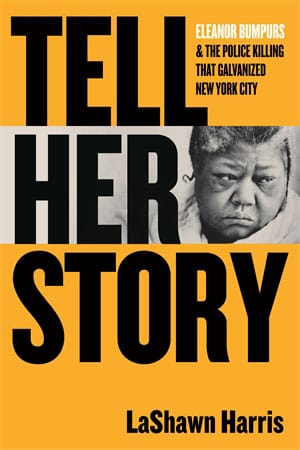author's pitch: how Eleanor Bumpurs became "more than my neighbor"

Today's author's pitch comes from Professor LaShawn Harris. She is an Associate Professor of History at Michigan State University. Her area of expertise includes twentieth century African American History & Black women’s History. Harris’ scholarly articles have appeared in The Journal of African American History, Journal of Social History, Journal of Urban History, and SOULS. Her first monograph Sex Workers, Psychics, and Number Runners: Black Women in New York City’s Underground Economy was published by the University of Illinois Press in 2016. Sex Worker, Psychics, and Numbers Runners won an Organization of American Historian (OAH) award for best book in African American women's history, and the Philip Taft Labor Prize in Labor and Working-Class History. Harris’ second book, Tell Her Story: Eleanor Bumpurs & the Police Killing that Galvanized New York City, was published by Beacon Press.
“The lady across the street was murdered. The cops shot her down, right in her apartment.”
I was 10 years old when a white New York Police Department (NYPD) officer killed Bronx resident and disabled grandmother Eleanor Gray Bumpurs. That day, officers had been dispatched to carry out what would become a botched, bloody eviction. I recall this horrific incident so vividly because Eleanor lived in the New York City’s Housing Authority’s (NYCHA) Sedgwick House complex—right across the street from my childhood home. In my new book, Tell Her Story: Eleanor Bumpurs and the Police Killing that Galvanized New York City, I explore this horrific event, as well as New Yorkers’ varying thoughts on the deadly eviction.
The news of Eleanor’s killing went viral 1980s style. Overnight, she became more than my neighbor, a 66-year-old beloved Black grandmother: now, she was a posterchild for New York City’s long histories of housing inequity, municipal disinvestment and neglect, and police violence. Eleanor’s killing laid bare the injustices that occur and the physical and mental carnage that awaits when multiple structures of oppression intersect and when social and economic safety nets are pulled from underneath vulnerable populations’ feet.
Eleanor’s name was in the New York Times and New York Amsterdam News, on radio broadcasts, and on daytime TV shows such as the nationally syndicated Phil Donahue show.
New Yorkers murmured it during Sunday morning sermons, in university lecture halls, in beauty salons and barbershops, and while they waited for city buses and trains. They affixed her image and name to protest placards and apartment buildings. Some Black, Latinx, and white writers, singers, street artists, and filmmakers dedicated their art to Eleanor. Several days after the eviction, Bronx high school students create a documentary about the incident. In 1989, Brooklyn filmmaker Spike Lee dedicated his film Do the Right Thing, a story centered on 1980s New York life and culture, to the Bumpurs families and other Black and Hispanic families that loss loved ones to police violence. And Eleanor’s death inspired Audre Lorde’s 1986 poem “For the Record, In Memory of Eleanor Bumpers.”
New Yorkers had much love for Eleanor. And that love—the belief that her life mattered—was the impetus for citywide action. Their loud cries for legal retribution signaled the makings of a social justice movement unlike any the city had ever witnessed, an early iteration of what legal scholar Kimberlé Crenshaw and the African American Policy Forum would later call the #SayHerName campaign in 2014.
Activists employed a myriad of strategies to secure legal justice for Bumpurs. Longtime Bronx city councilman Wendell Foster organized political rallies on the steps of Manhattan’s City Hall. Bronx activists established grassroots organizations like the Eleanor Bumpurs Justice Committee. And New Yorkers organized letter writing campaigns to elected officials. In January 1987, incarcerated activists at New York’s Attica Correctional Facility send a petition to the Bronx district attorney, calling for the “expeditious prosecution” of the officer that “murdered Eleanor Bumpurs.” Public pressure resulted in policy changes within the NYPD and a lengthy legal battle for justice.
Burgeoning social justice movement protests for Eleanor were part of dynamic 1980s Black Diasporic movements aimed at eradicating race, gender, and labor inequality, global apartheid and oppression, and police violence. As Eleanor’s supporters rallied on the steps of Manhattan’s City Hall and on busy Bronx and Brooklyn throughfares, citizens in Los Angeles, Miami, Norfolk, and Philadelphia battled against unfettered police repression. Thousands of urban citizens descended on city streets, orchestrating rallies over the police slayings of Californian Eula Love (1979) and members and children of Philadelphia’s Black liberation organization MOVE (1985).
I wrote this book to tell Eleanor’s story. I wrote it to introduce you to a woman with a rich interior life, whose family love and grieve her to this day. And I wrote it to introduce you to a community that showed up and demanded legal justice for Eleanor through acts both small and large. When we tell her story today, we see how a police murder committed 4 decades ago rings painfully true to one that occurred last week, last month, last year. But we also make space for crucial conversations—about our fragile and failing mental health services, public housing programs, policing systems—and we commit ourselves to the work of building a world that’s safe and supportive for all, one community at a time.
TELL HER STORY: Eleanor Bumpurs & the Police Killing that Galvanized New York City
Carceral History is an always free newsletter provided as a professional service by a mid-career jail historian living in the heart of Connecticut.
Interested in contributing? Email carceralhistory@gmail.com.

